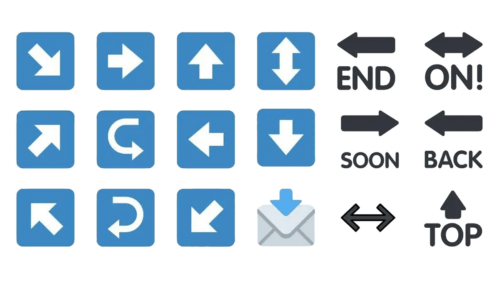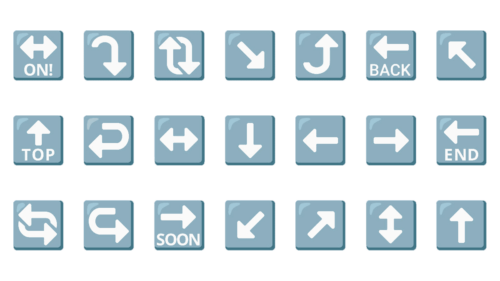In addition to everyone’s favorite funny faces, flowers, animals, and ornaments, the Unicode set also includes more traditional and “strict” emoji, which are used not to express emotions, but to reinforce the meaning of what is written, or to give directions. One of the most commonly used categories of such emoji is undoubtedly the Arrow Emoji. Below we have collected for you all the variants of the arrow emoji, with their official names, which explain their meaning and context of use.
Meaning and Use of the Arrow Emoji
⬇️ The Down Arrow emoji was assigned the code U+2B07 U+FE0F, with which it was added to the Symbols section of the Unicode 4.0 standard in 2003.
⬆️ The Up arrow is a fully qualified emoji as part of Unicode 4.0, which was introduced in 2003, and was added to Emoji 0.6.
↙️ The Left Down Arrow is a fully qualified emoji within Unicode 1.1, which was introduced in 1993, and was added to Emoji 0.6.
➡️ The Right arrow – fully qualified emoji as part of Unicode 1.1, which was introduced in 1993, and was added to Emoji 0.6.
↘️ The Right Down Arrow is a fully qualified emoji as part of Unicode 1.1, which was introduced in 1993, and has been added to Emoji 0.6.
↗️ The Up-right arrow – a fully qualified emoji as part of Unicode 1.1, which was introduced in 1993, and was added to Emoji 0.6.
↖️️ The Up-left arrow is a fully qualified emoji in Unicode 1.1, which was introduced in 1993, and was added to Emoji 0.6.
⬇️ The Down arrow is a fully qualified emoji as part of Unicode 4.0, which was introduced in 2003, and was added to Emoji 0.6.
⬅️ The Left arrow is a fully qualified emoji within Unicode 4.0, which was introduced in 2003 and has been added to Emoji 0.6.
🔃 Vertical arrows is a fully qualified emoji as part of Unicode 6.0, which was introduced in 2010, and was added to Emoji 0.6.
🔄 Counterclockwise arrows – A fully qualified emoji within Unicode 6.0, which was introduced in 2010, and was added to Emoji 1.0.
↕️ Up-down arrow is a fully qualified emoji as part of Unicode 1.1, which was introduced in 1993 and has been added to Emoji 0.6.
⤴️ Right-turned-up arrow is a fully qualified emoji as part of Unicode 3.2, which was introduced in 2002, and was added to Emoji 0.6.
↩️️ Left-turning arrow is a fully qualified emoji in Unicode 1.1, which was introduced in 1993, and was added to Emoji 0.6.
↪️️ Right-turning arrow is a fully qualified emoji as part of Unicode 1.1, which was introduced in 1993, and was added to Emoji 0.6.
⤵️ Right-turning down arrow is a fully qualified emoji in Unicode 3.2, which was introduced in 2002, and was added to Emoji 0.6.
🔁 Repeat button – a fully qualified emoji as part of Unicode 6.0, which was introduced in 2010.
🔙 Back arrow is a fully qualified emoji as part of Unicode 6.0, which was introduced in 2010.
🔜 The “Soon” arrow is a fully qualified emoji as part of Unicode 6.0, which was introduced in 2010.
🔝 The “Top” arrow is a fully qualified emoji as part of Unicode 6.0, which was introduced in 2010.
🔚 The End arrow is a fully qualified emoji as part of Unicode 6.0, which was introduced in 2010.
🔛 The “On!” arrow – is a fully qualified emoji in Unicode 6.0 that was introduced in 2010.
Conclusion
As you can see, the emoji in this category are very clear and do not have a large number of variations in their meaning. Use the Arrow Emoji to indicate directions, movement, traffic, or in a more figurative sense – when an item on the list needs to be raised in importance, or, conversely, lowered in importance. Horizontal arrows also often mean “let’s move on”, or “let’s go back a bit to the previous topic”, or to ask someone to re-read the thing you have written before.








